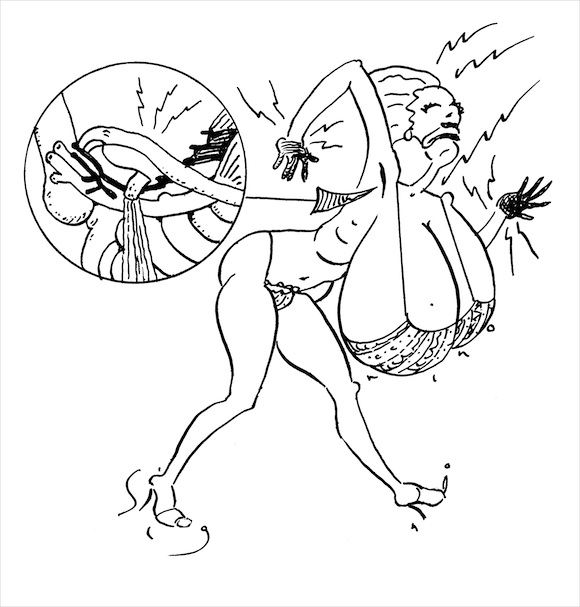
On “Hollywood Squares” the other night, one of the questions was: “What medical problem are women with a D-cup or larger more likely to get?” The answer was carpal tunnel syndrome! What’s the connection? Do they get it from lifting their arms, or is the carpal tunnel gene attached to the large-breast gene, or what? — Nicki F.
Plenty of men, including some septuagenarian sportscasters, find big boobs fascinating, and some women, often with surgical assistance, have made careers out of pushing their buttons. (If you’d argue Katherine Webb doesn’t really fit the profile here, try Googling Jenn Sterger.) But life for the well-endowed isn’t necessarily one long day at the beach.
Carpal tunnel syndrome is far from the worst that can happen. In 1669 a physician reported on a 24-year-old woman who couldn’t get out of bed due to having breasts collectively weighing around 100 pounds — 64 for the left, an estimated 40 for the right. I regret to say this was established on autopsy. The cause of death wasn’t clear; the woman’s breasts reportedly had grown to these gargantuan proportions literally overnight, and she was otherwise emaciated. Nonetheless, we may reasonably conclude: big boobs kill.
Getting back to carpal tunnel syndrome, or CTS: The most common proximate cause is trapping or compressing the median nerve in the wrist, where it passes through the narrow channel that gives the syndrome its name. In many cases, though, it’s hard to pinpoint exactly what brought the condition on. Symptoms typically include burning, tingling, or numbness of the fingers and thumb, sometimes radiating all the way up to the shoulder. CTS is most commonly found among those putting a lot of stress on their wrists during the day: this typically includes housewives and workers using vibrating tools, but not, contrary to what was once widely believed, workers typing on computer keyboards.
Big-breasted women are far more likely to have carpal tunnel problems than the rest of us. In the general population, maybe one in 40 people is affected; for well-endowed women it’s more like one in five. Interestingly, 62 percent of pregnant women get CTS during their third trimester, when their breasts are enlarged. Doctors aren’t sure why, but a plausible guess is pinched nerves not in the wrist but rather somewhere upstream.
One likely location is the shoulder, where the weight of oversize mammaries can produce considerable stress. Big-breasted women often complain of bra straps cutting into their shoulders, putting pressure on something known as the costoclavicular passage. The result can be pain, tingling, tickling, and numbness in the shoulders and down the arms, to the point of the hands turning blue. Another problem along these lines is thoracic outlet syndrome, a combination of pain, weakness, and other neurological issues caused by compressing blood vessels and nerves in the shoulder.
Symptoms for all these conditions overlap somewhat, and I’m guessing they’re not that easy to distinguish. We surmise, therefore, that it’s not so much big breasts causing carpal tunnel syndrome strictly defined — that is, pinched nerves in the wrists. Rather, they can lead to numbness, tingling, and pain for various reasons at various spots in the upper extremities, and the description “carpal tunnel syndrome” is applied indiscriminately regardless of actual cause.
But let’s go on. Other afflictions of the big-bosomed include:
- Headaches, back and neck pain, spinal degeneration, and slipped discs. One study found a 25-year-old woman with B-cup-size breasts has an 8 percent chance of developing spine disorders, whereas a woman with a D-cup has a 44 percent chance. The problem worsens with age — by the time the D-cup woman reaches 35, she’s got an 82 percent chance of having back trouble.
- Skin irritation caused by moisture and bacteria trapped within folds of skin.
- Chafing and the like due to bouncing during jogging or other exercise.
- Shortness of breath due to weight pressing on the rib cage.
- Posture and sleeping difficulties.
The solution for some is breast reduction surgery. One study found 90 percent of large-breasted women with CTS-like symptoms saw partial or complete improvement after surgery. Neck, shoulder and back pain, headaches, pinching bra straps, and exercise abrasion also are often reduced or eliminated, it’s easier to find clothes that fit, and you attract less unwanted scrutiny. Schoolboys for whom 48DD represents the pinnacle of female beauty may recoil at the thought, but they might consider the inconvenience of walking around with two 10-pound water balloons hung around their necks.
QUESTIONS WE’RE STILL THINKING ABOUT
Do train drivers ever get lost? — Bernie
I used to think questions like this were diagnostic of mental deficiency. Then I heard about the Swedish railroad custodian who accidentally started a train she was cleaning, whereupon it ran to the end of the line, jumped the tracks, skittered 30 yards across the snow, and crashed into an apartment building. So let’s just say while a train driver can’t get lost in the sense that a Boy Scout in the woods can get lost, it’s possible to take a seriously wrong turn.
— CECIL ADAMS
Send questions to Cecil via straightdope.com or write him c/o Chicago Reader, 350 N. Orleans, Chicago 60654. Subscribe to the Straight Dope podcast at the iTunes Store.
